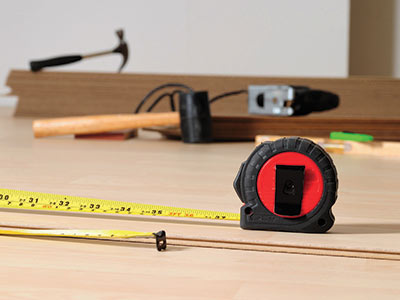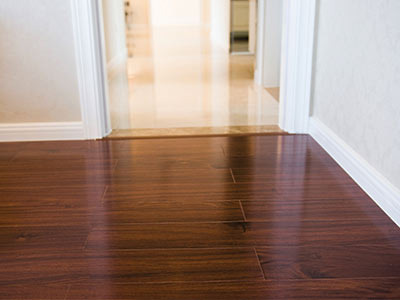Back to Floor Sanding
Engineered Wood Floor Sanding Guide

Can you sand engineered wood floors? Absolutely! Engineered wood flooring has skyrocketed in popularity and appreciation. It’s no wonder this type of flooring is becoming the top choice for many households and commercial premises. The increasing preference for engineered wood floors over classic timber floors stems from their resilience to moisture, humidity, and temperature fluctuations—issues that often plague solid wood flooring.
Solid wood floors are undeniably beautiful, elegant, and timeless, matching all sorts of interior styles and designs. However, they are not easy to maintain and keep in perfect condition for extended periods. The naturally porous structure of solid wood can react negatively to excessive moisture, humidity, and temperature changes. Therefore, solid wood floors are generally not recommended for bathrooms, kitchens, basements, conservatories, or areas with high indoor moisture. They also require a specific cleaning and maintenance routine, leading many to seek alternatives. This demand led to the design and popularity of engineered wood flooring.
What makes engineered wood flooring different is its advanced structure. Layers of softwood or plywood are glued together in a crisscrossed construction, forming the core of engineered wood flooring. This core is topped with a lamella layer of hardwood, available in various wood species, colours, patterns, and designs. Unlike laminate, which is often confused with engineered wood, engineered wood is made entirely from real wood products. Therefore, you can sand engineered wood flooring just like solid wood, making it look amazing and brand new repeatedly. Depending on the thickness of the lamella hardwood layer, sanding can be done several times throughout the floor’s lifespan.
This is great news for those considering engineered wood flooring for their home or workspace. Sanding engineered wood floors can restore their appearance, whether due to wear and tear from high traffic or other issues and imperfections. Let’s delve into more about sanding engineered wood floors and explore the five most important steps of this process!
Preparation for Sanding Engineered Wood Floors
Proper preparation is crucial before sanding engineered wood floors to ensure a smooth and effective process. Here’s how to get your space ready:
-
Clear the Room: Remove all furniture, heavy objects, decorations, and anything else that might obstruct the sanding machine or get damaged. This will allow for unrestricted movement of the sanding equipment and prevent damage to your belongings.
-
Protect Your Space: Sanding can create a lot of dust, even though modern sanding machines are highly effective at collecting it. To minimise dust transfer to other areas of your home, cover windows and doors with plastic sheets. This helps contain the mess and keeps the rest of your space clean.
-
Clean the Floor: Thoroughly clean the engineered wood floor to remove any dirt, debris, or residue. A clean surface is essential for effective sanding and to ensure that the sanded floor finishes evenly.
Choosing the Right Grit for Sanding Engineered Wood Floors
To achieve the best results when sanding engineered wood floors, selecting the appropriate sandpaper grit is essential. The sanding process typically involves using sandpaper of varying grits to gradually refine the surface and eliminate imperfections. Here’s a guide on how to use different grits effectively:
-
Coarse Grit (40-60): Begin with coarser sandpaper in the 40 to 60 grit range. This step is crucial for removing any significant imperfections, old finishes, or uneven areas on the floor. Coarse grit sandpaper will help to level the surface and prepare it for finer sanding.
-
Medium Grit (80-100): After addressing the major imperfections with coarse grit, switch to medium grit sandpaper (80 to 100). This stage smooths out the surface further, removing scratches left by the coarser grit and preparing the floor for the final sanding.
-
Fine Grit (120-150): Finish the sanding process with fine grit sandpaper, typically between 120 and 150. This step ensures a smooth, even, and uniform surface with no visible bumps or scratches. Fine grit sandpaper provides the final touch, making the surface ready for finishing or sealing.
-
Extra Fine Grit (180-220) (Optional): For an ultra-smooth finish, especially if you plan to apply a high-gloss finish, you might consider using extra fine grit sandpaper (180 to 220) as a final step. This additional sanding will help achieve a pristine, professional-quality surface.
Additional Tips
- Sanding Direction: Always sand in the direction of the wood grain to avoid noticeable scratch patterns and to achieve a smoother finish.
- Vacuum Frequently: Regularly vacuum the floor between sanding stages to remove dust and debris, ensuring a cleaner work environment and better results.
- Check Your Work: Frequently inspect the floor for any remaining imperfections or uneven areas and address them before moving on to finer grits.
Types of Sanders for Engineered Wood Floor Sanding

Achieving a flawless finish when sanding engineered wood floors requires the right tools. Different sanders are suited for various stages of the sanding process, each contributing to a smooth and even surface. Here’s an overview of the essential sanders and their roles:
-
Belt Sanders:
- Purpose: Belt sanders are powerful machines designed for heavy-duty sanding. They are ideal for the initial stages of the sanding process.
- Usage: Use a belt sander to remove old finishes, major imperfections, scratches, dents, and stains. The aggressive sanding action helps quickly level the floor and prepare it for finer sanding.
- Features: Equipped with a continuous loop of sandpaper, belt sanders are efficient for large areas but can be challenging to manoeuvre around edges and corners.
-
Disc Sanders:
- Purpose: Disc sanders, including both floor and hand-held models, are versatile tools suitable for both initial and intermediate sanding.
- Usage: Ideal for tackling significant imperfections and for working on flat surfaces. They offer precision and control, making them useful for detailed sanding after using a belt sander.
- Features: Disc sanders use rotating sanding discs, providing a uniform sanding pattern. They are often used in conjunction with other sanders to achieve the desired finish.
-
Edge or Detail Sanders:
- Purpose: Edge sanders are designed for detailed work, reaching areas that are difficult to access with larger machines.
- Usage: Use edge sanders to sand along the edges of the room, around baseboards, and in corners. They ensure that no areas are missed, contributing to a uniform finish across the entire floor.
- Features: Typically smaller and more manoeuvrable, these sanders are essential for completing the sanding process in areas that larger sanders cannot reach.
-
Orbital Sanders:
- Purpose: Orbital sanders, also known as finishing sanders, are used for the final stages of sanding.
- Usage: These sanders are designed for fine sanding, smoothing out the floor and eliminating any remaining scratches or imperfections. They are perfect for achieving a silky-smooth finish.
- Features: Orbital sanders use a circular sanding motion and are equipped with finer grit sandpaper. They are ideal for the final pass before applying a finish or sealant.
Additional Tips
- Choose the Right Grit: Match the sandpaper grit to the sander being used and the stage of the sanding process.
- Move Slowly and Steadily: For best results, move the sander slowly and steadily to avoid uneven sanding and to ensure a consistent finish.
- Regularly Check Progress: Frequently inspect the floor to ensure that all areas are evenly sanded and that no imperfections remain.
By using these different sanders appropriately, you’ll achieve a perfectly smooth and even finish on your engineered wood floors, ready for a fresh coat of finish or sealant.
Sanding with the Grain: Why It Matters
Sanding engineered wood floors correctly is essential for achieving a flawless finish and prolonging the life of your flooring. One of the most important techniques in this process is sanding with the grain of the wood. Here’s why this approach is crucial and how it benefits your sanding project:
-
Achieve a Smooth Finish:
- Benefits: Sanding with the grain helps to create a smooth and even surface. Sanding in the direction of the wood grain ensures that the final finish will be consistent and free from visible scratch marks or patterns.
- Technique: Always move the sander parallel to the wood grain. This method helps in blending any previous scratches and imperfections, resulting in a more seamless look.
-
Minimise Damage:
- Avoid Scratches: Sanding against the grain can lead to scratches and grooves that become more noticeable after finishing. These scratches can mar the appearance of the floor and make the final result less appealing.
- Prevent Wear and Tear: Floors sanded against the grain may develop uneven wear over time. This can lead to more significant issues, including the need for costly repairs or refinishing sooner than expected.
-
Enhance Durability:
- Long-Term Benefits: Properly sanding with the grain ensures that the engineered wood floor maintains its structural integrity and visual appeal. By following this technique, you help preserve the floor's durability and reduce the risk of future damage.
-
Detailed Sanding Process:
- Initial Sanding: Begin with coarse-grit sandpaper and follow the grain direction to remove major imperfections and old finishes.
- Intermediate Sanding: Move to medium-grit sandpaper, continuing to sand with the grain to further smooth the surface.
- Final Sanding: Use fine-grit sandpaper to achieve a polished and smooth finish, ensuring all previous sanding marks are eliminated.
Additional Tips
- Check Grain Direction: Before starting, identify the direction of the wood grain. This can usually be determined by looking closely at the surface or observing the natural pattern of the wood.
- Avoid Overlap: Ensure that each pass of the sander overlaps slightly with the previous pass to maintain a consistent finish and avoid missed spots.
- Inspect Frequently: Regularly check your progress to ensure that sanding marks are consistent with the grain direction and that no cross-grain scratches are present.
By sanding with the grain, you ensure that your engineered wood floors achieve the best possible finish, enhancing their appearance and longevity while avoiding unnecessary damage and future maintenance issues.
Final Cleaning Before Refinishing
Once sanding your engineered wood floor is complete, meticulous cleaning is essential before applying any finish or stain. Any residual dust or dirt left on the floor's surface can lead to uneven coverage and blemishes in the final finish. Dirt particles trapped between the surface and the finish will be difficult or impossible to remove afterwards. Additionally, floor stains can accentuate these imperfections, resulting in an uneven appearance. To achieve a flawless finish, ensure the floor is thoroughly cleaned, free of all debris, and completely dry before proceeding with refinishing and staining.